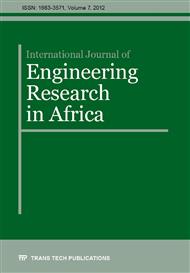[1]
E.A. Weiss, Oil seed crops, Tropical Agriculture Series. Longman, London, (1983).
Google Scholar
[2]
S. Pabis, D.S. Jayas and S. Cenkowski, Grain Drying: Theory and Practice, John Wiley & Sons Inc., New York, NY, (1998).
Google Scholar
[3]
A. Midilli, H. Kucuk and Z.A. Yapar, New model for single-layer drying. Drying Technology 20 (7) (2002) 1503 – 1513.
DOI: 10.1081/drt-120005864
Google Scholar
[4]
P.C. Panchariya, D. Popovic and A.L. Sharma, Thin-layer modeling of black tea drying process, Journal of Food Engineering 52 (2002) 349 – 357.
DOI: 10.1016/s0260-8774(01)00126-1
Google Scholar
[5]
E.K. Akpinar, Y. Bicer and A. Midilli, Modeling and experimental study on drying of apple slices in a convective cyclone dryer. Journal of Food Process Engineering 26 (6): (2003) 515 – 541.
DOI: 10.1111/j.1745-4530.2003.tb00654.x
Google Scholar
[6]
E.K. Akpinar and Y. Bicer, Mathematical modeling and experimental study on thin-layer drying of strawberry, International Journal of Food Engineering 2 (1) (2006) 1 – 17.
DOI: 10.2202/1556-3758.1045
Google Scholar
[7]
O.O. Ajibola, Thinlayer drying of melon seed, Journal of Food Engineering. 9 (1989) 305- 320.
Google Scholar
[8]
O.P. Sobukola and O.U. Dairo, Modeling drying kinetics of fever leaves(ocimen viride) in a convective hot air drier., Nigerian Food Journal 25 (1) (2007) 145 – 153.
DOI: 10.4314/nifoj.v25i1.33663
Google Scholar
[9]
O.P. Sobukola, O.U. Dairo, L.O. Sanni, A.V. Odunewu and B.O. Fafiolu, Thinlayer drying process of some leafy vegetables under open sun drying. Food science and Technology International 13 (1) (2007) 35 – 40.
DOI: 10.1177/1082013207075953
Google Scholar
[10]
M.A. Karim and M.N.A. Hawlader, Drying characteristics of banana: Theoretical and experimental validation, Journal of Food Engineering 70 (2005) 35 – 45.
DOI: 10.1016/j.jfoodeng.2004.09.010
Google Scholar
[11]
I. Doymaz, Convective air drying characteristics of thin layer carrots, Journal of Food Engineering 61 (2004) 359 – 364.
DOI: 10.1016/s0260-8774(03)00142-0
Google Scholar
[12]
DI. oymaz, Drying behaviour of green beans, Journal of Food Engineering 69 (2005) 161 – 165.
Google Scholar
[13]
M. Parti, Selection of mathematical models for drying grain in thin-layers, Journal of Agricultural Engineering Research 54 (1993) 339-352.
DOI: 10.1006/jaer.1993.1026
Google Scholar
[14]
D.S. Jayas, S. Cenkowski, S. Pabis and W.E. Muir, Review of thin layer drying and rewetting equations, Drying Technology 9 (1991) 551-558.
DOI: 10.1080/07373939108916697
Google Scholar
[15]
S.T.A.R. Kajuna, V.C.K. Silayo, A. Mkenda and P.J.J. Makungu, Thin-layer drying of diced cassava roots, African Journal of Science and Technology: Science and Engineering Series 2 (2) (2001) 94 – 100.
DOI: 10.4314/ajst.v2i2.44677
Google Scholar
[16]
C.L. Hii, C.L. Law and M. Cloke, Modelling of thin layer drying kinetics of cocoa beans during artificial and natural drying, Journal of Engineering Science and Technology 3 (1) (2008) 1 – 10.
Google Scholar
[17]
M.K. Misraand D.B. Brooker, Thin layer drying and rewetting equations for shelled yellow corn, Transactions of the ASAE 23 (1980) 1254-1260.
DOI: 10.13031/2013.34756
Google Scholar
[18]
R. Tabatabaee, D.S. Jayas and N.D.G. White, Thin-layer drying and rewetting characteristics of buckwheat, Canadian Biosystems Engineering 46 (3) (2004) 19 – 24.
Google Scholar
[19]
L.R. Verma, R.A. Bucklin, J.B. Endan and F.T. Wratten, Effects of drying air parameters on rice drying models, Transactions of the American Society of Agricultural Engineers 28 (1985) 296-301.
DOI: 10.13031/2013.32245
Google Scholar
[20]
J.F. oung, T.R. Whitaker, P.D. Blankershy, G.I.T. Brusenitz, J.M. Troeger, J.L. Stees, and N.K. Person, Effect of oven drying time on peanut moisture determination, Transactions of the American Society of Agricultural Engineers 25 (2) (1982).
DOI: 10.13031/2013.33560
Google Scholar
[21]
Datafit Oakdale. Data fit version 9. 05 Oakdale Engineering, Oakdale, PA 15070, USA. (2008).
Google Scholar
[22]
C. Ertekin and O. Yaldiz, Drying of eggplant and selection of a suitable thin layer drying model, Journal of Food Engineering 63 (2004) 349 – 359.
DOI: 10.1016/j.jfoodeng.2003.08.007
Google Scholar
[23]
M.A. Basunia and T. Abe, Thin-layer solar drying characteristics of rough rice under natural convention, Journal of Food Engineering 47 (2001) 295 – 301.
DOI: 10.1016/s0260-8774(00)00133-3
Google Scholar
[24]
J. Khazaei, Natural drying characteristics of sesame seeds, Cercetări Agronomice în Moldova XLI (3) (2008) 135.
Google Scholar
[25]
M. Kashaninejad, A. Mortazavi, A. Safekordi and L.G. Tabil, Thin-layer drying characteristics and modeling of pistachio nuts, Journal of Food Engineering 78 (2007) 98 – 108.
DOI: 10.1016/j.jfoodeng.2005.09.007
Google Scholar
[26]
J. Crank, The mathematics of diffusion, Oxford University Press, London, (1975).
Google Scholar
[27]
A.L. Gaston, R.M. Abalone, S.A. Giner and D.M. Bruce, Effect of modeling assumptions on the effective water diffusivity in wheat, Biosystems Eng. 88 (2), (2004) 175-185.
DOI: 10.1016/j.biosystemseng.2004.02.009
Google Scholar
[28]
R.P.F. Guine and R.M.C. Fernandes, Analysis of the drying kinetics of chestnuts, Journal of Food Engineering 76 (2006) 460-467.
Google Scholar
[29]
K. Sacilik, Effect of drying methods on thin-layer drying haracteristics of hull-less seed pumpkin (Cucurbita pepo L. ), Journal of Food Engineering 79 (1) (2007) 23-30.
DOI: 10.1016/j.jfoodeng.2006.01.023
Google Scholar
[30]
J. Khazaei and S. Daneshmandi, Modeling of thin-layer drying kinetics of sesame seeds: mathematical and neural networks modeling, Int. Agrophysics 21 (2007) 335-348.
Google Scholar
[31]
P.S. Madamba, R.H. Driscoll and K.A. Buckle, The thin layer drying characteristics of garlic slices, Journal of Food Engineering 29 (1996) 75 – 97.
DOI: 10.1016/0260-8774(95)00062-3
Google Scholar
[32]
D. Doulia, K. Tizia and G. Gekas, A knowledge base for apparent mass diffusivity (Deff) of Foods: physical properties of food database. http: /www. nelfood. com. Available at Accessed September 20, (2009).
Google Scholar


